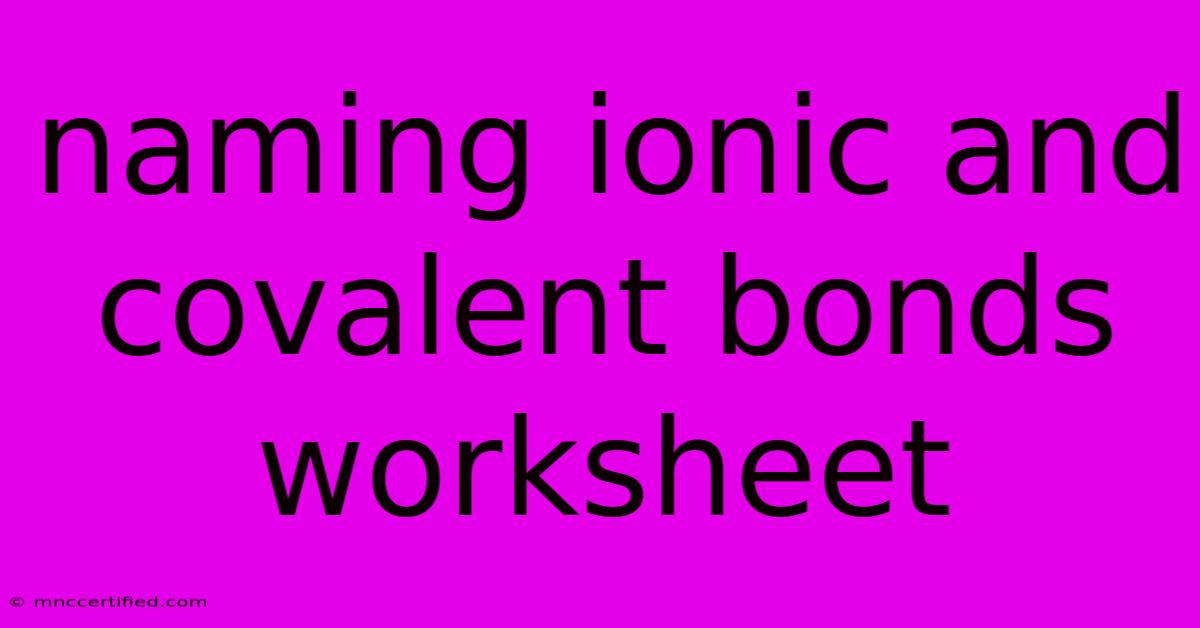Naming Ionic And Covalent Bonds Worksheet

Table of Contents
Mastering the Art of Naming Ionic and Covalent Bonds: A Worksheet Guide
Understanding the differences between ionic and covalent bonds is fundamental to comprehending the nature of chemical compounds. This comprehensive guide, coupled with a handy worksheet, will equip you with the skills needed to accurately name these bonds and the compounds they form.
Delving into the World of Bonds
Before we jump into naming, let's clarify the distinctions between these two essential bond types:
Ionic Bonds:
- Formation: Occur when a metal atom transfers electrons to a non-metal atom. This creates positively charged cations and negatively charged anions.
- Characteristics: Strong electrostatic attraction between oppositely charged ions, resulting in crystalline solids with high melting and boiling points.
Covalent Bonds:
- Formation: Occur when non-metal atoms share electrons to achieve a stable electron configuration.
- Characteristics: Can be single, double, or triple bonds, depending on the number of shared electrons. Form molecules with varying melting and boiling points.
The Naming Game: Ionic Compounds
Naming ionic compounds follows a set of specific rules:
- Cation: The name of the metal cation is written first.
- Anion: The name of the non-metal anion is written second, with the suffix "-ide" added.
- Roman Numerals: If the metal can form more than one cation (like iron or copper), a Roman numeral is included in parentheses after the metal's name to indicate its charge.
Example:
- NaCl: Sodium chloride (sodium is a group 1 metal, so it always has a +1 charge. Chlorine is a group 17 non-metal, so it always has a -1 charge.)
- FeCl2: Iron(II) chloride (Iron can have charges of +2 or +3. Here, it has a +2 charge.)
- FeCl3: Iron(III) chloride (Here, iron has a +3 charge.)
The Naming Game: Covalent Compounds
Naming covalent compounds follows a different set of rules:
- Prefixes: Greek prefixes (mono, di, tri, tetra, etc.) are used to indicate the number of each element present in the compound.
- Non-metal Names: The names of the non-metal elements are used, with the less electronegative element listed first.
- "-ide" Suffix: The suffix "-ide" is added to the second element's name.
Example:
- CO: Carbon monoxide (one carbon atom, one oxygen atom)
- CO2: Carbon dioxide (one carbon atom, two oxygen atoms)
- N2O4: Dinitrogen tetroxide (two nitrogen atoms, four oxygen atoms)
Your Naming Adventure: The Worksheet
Now it's time to put your knowledge into practice! Below is a worksheet that will test your understanding of naming ionic and covalent compounds.
Worksheet:
Part 1: Ionic Compounds
-
Name the following ionic compounds:
- KBr
- CaO
- AlCl3
- Fe2O3
-
Write the chemical formulas for the following ionic compounds:
- Magnesium chloride
- Potassium sulfide
- Copper(I) oxide
- Aluminum oxide
Part 2: Covalent Compounds
-
Name the following covalent compounds:
- N2O5
- SO3
- PCl5
-
Write the chemical formulas for the following covalent compounds:
- Carbon tetrachloride
- Sulfur trioxide
- Diphosphorus pentoxide
Answers:
(Answers to the worksheet are provided in a separate section at the end of this article.)
Conquering the Chemical World
This worksheet will guide you through the process of correctly naming ionic and covalent compounds. By working through the exercises, you'll develop a strong foundation in understanding the basic concepts of chemical bonding. As you progress, you'll be able to apply this knowledge to more complex chemical systems and reactions.
Answers to the Worksheet
Part 1: Ionic Compounds
-
- KBr: Potassium bromide
- CaO: Calcium oxide
- AlCl3: Aluminum chloride
- Fe2O3: Iron(III) oxide
-
- Magnesium chloride: MgCl2
- Potassium sulfide: K2S
- Copper(I) oxide: Cu2O
- Aluminum oxide: Al2O3
Part 2: Covalent Compounds
-
- N2O5: Dinitrogen pentoxide
- SO3: Sulfur trioxide
- PCl5: Phosphorus pentachloride
-
- Carbon tetrachloride: CCl4
- Sulfur trioxide: SO3
- Diphosphorus pentoxide: P2O5
Note: This worksheet is a starting point. You can expand it by adding more complex examples or exploring the nuances of naming compounds with polyatomic ions.
Further Exploration:
- Practice naming compounds with polyatomic ions (e.g., sulfate, phosphate, nitrate).
- Explore the different types of covalent bonds (single, double, triple).
- Research the properties of ionic and covalent compounds and their applications.
By understanding and applying the rules of naming, you can confidently communicate chemical information and explore the exciting world of chemistry!

Thank you for visiting our website wich cover about Naming Ionic And Covalent Bonds Worksheet. We hope the information provided has been useful to you. Feel free to contact us if you have any questions or need further assistance. See you next time and dont miss to bookmark.
Featured Posts
-
Refferral Code Zearn Crypto Referral Code
Nov 07, 2024
-
Vance Trump Ally Elected Vp
Nov 07, 2024
-
Millwall Boss On Leeds United X Factor
Nov 07, 2024
-
Early Results Show Lurie Ahead In San Francisco Mayoral Race
Nov 07, 2024
-
Election Results Trump Wins Walzs County
Nov 07, 2024